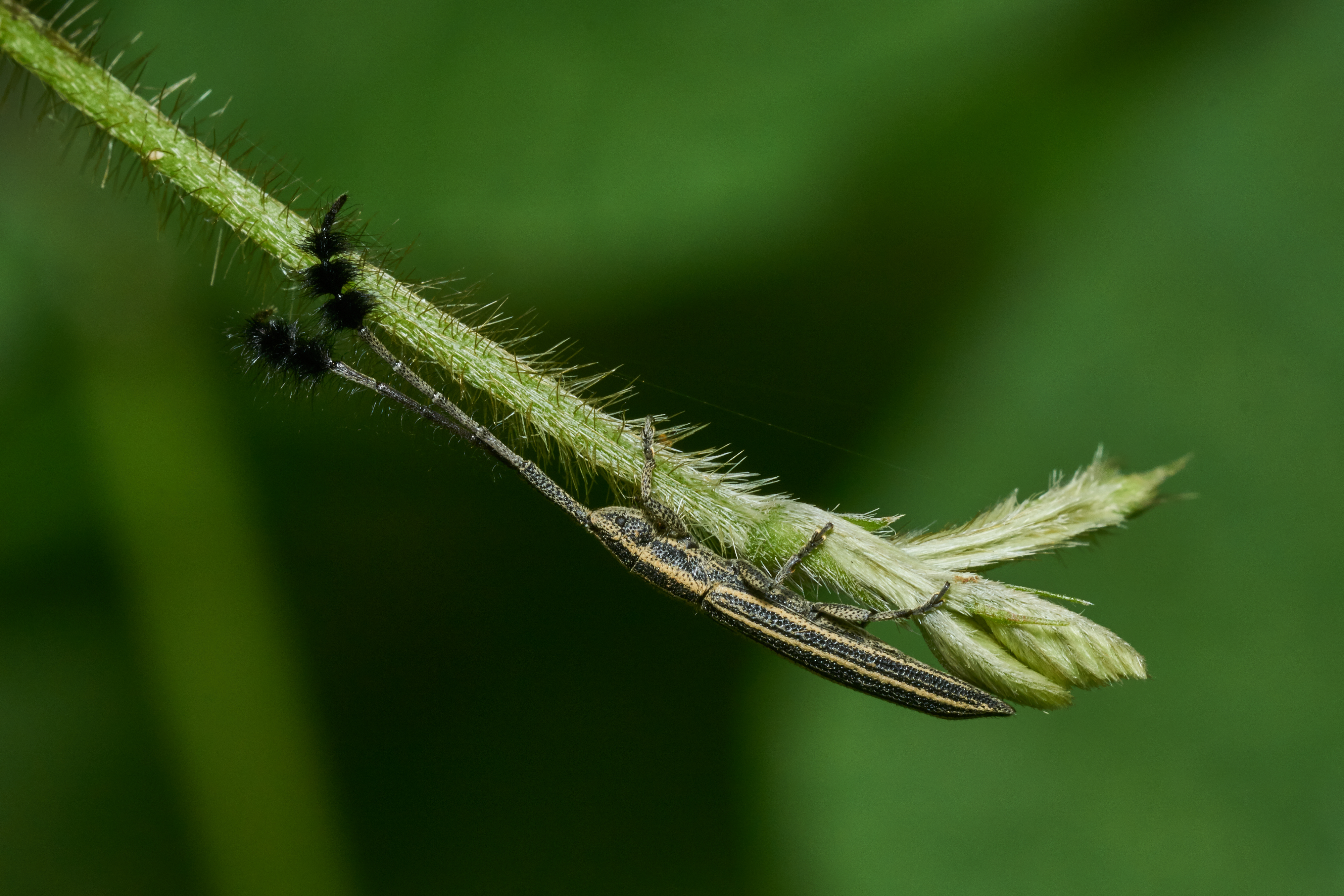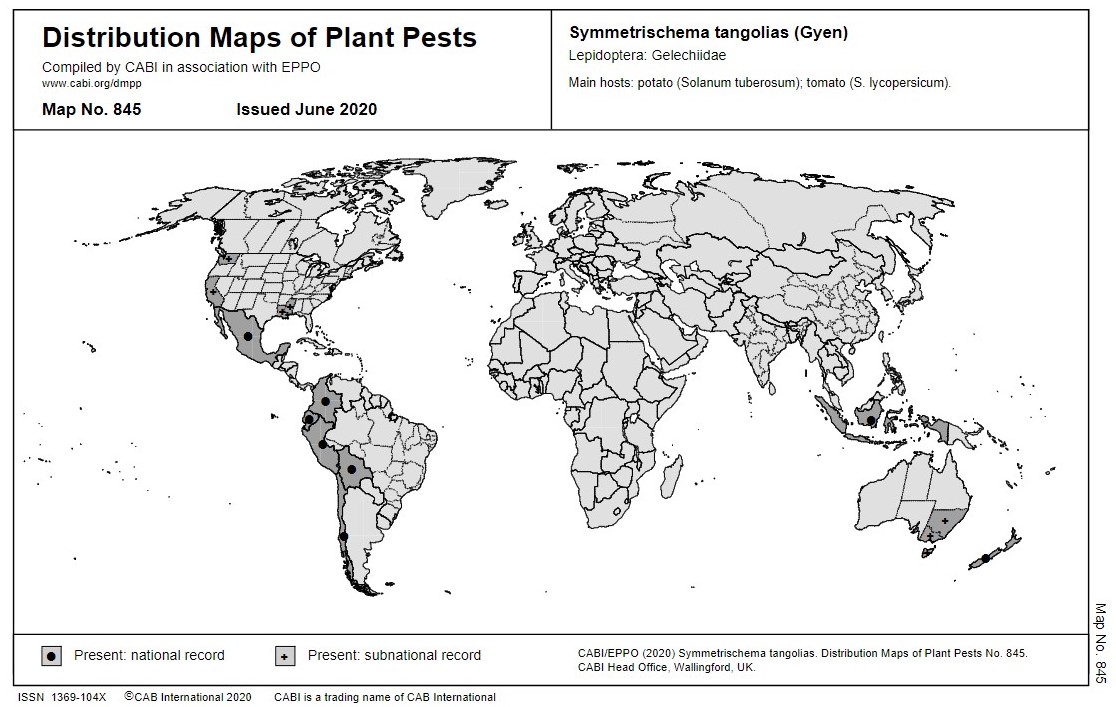|
Stemborer
A stemborer (stem borer) is any insect larva, or arthropod, that bores into plant stems. However the term most frequently refers among the Coleoptera to the larva of certain longhorn beetles such as '' Dorysthenes buqueti'' and those of the genus '' Oberea'', and among the Lepidoptera to certain moths of the Crambidae, Castniidae, Gelechiidae, Nolidae, and Pyralidae The Pyralidae, commonly called pyralid moths, snout moths or grass moths, are a family of Lepidoptera in the ditrysian superfamily Pyraloidea. In many (particularly older) classifications, the grass moths (Crambidae) are included in the Pyr ... families. Stem borers include: ;Coleoptera *Banana stemborer weevil ('' Cosmopolites sordidus'') * Coffee white stem borer (''Xylotrechus quadripes'') * Sugarcane longhorn stemborer (''Dorysthenes buqueti'') ;Lepidoptera *African pink stemborer ('' Sesamia calamistis'') * African white stemborer (''Maliarpha separatella'') * Asiatic rice stemborer (striped rice stembore ... [...More Info...] [...Related Items...] OR: [Wikipedia] [Google] [Baidu] |
Tomato Stemborer
The South American potato tuber moth, Andean potato tuber moth or tomato stemborer (''Symmetrischema tangolias'') is a moth of the family Gelechiidae. It is native to South America, but has become a pest worldwide. Records include North America, Australia and New Zealand. Species Description Tomato stemborer eggs are shaped oval and have a size of 0.7 x 0.4 mm for a freshly laid egg. The colouration changes to orange-yellow when the eggs start to develop and turn to dark gray before hatching. However, there is not much known about the caterpillar stage on tomato stemborer. Adult moths typically lay their eggs on invaded plants during nighttime. The larva is typically slender and cylindrical with pinkish, dark head capsule and segments are distinct; caterpillar has small, bristle-like structures on its body. The pupal stage occurs within a cocoon, with dark brown colouration encased in a protective shell. The adult moth has distinctive black triangle patches along the lateral mar ... [...More Info...] [...Related Items...] OR: [Wikipedia] [Google] [Baidu] |
Sesamia
''Sesamia'' is a genus of moths of the family Noctuidae erected by Achille Guenée in 1852. Most but not all of its species are Afrotropical in distribution, with a preference for humid, open habitats. Larvae are stemborers, and several species of ''Sesamia'' are known agricultural pests on cereals, such as ''Sesamia calamistis'', the African pink stemborer, and ''Sesamia inferens ''Sesamia inferens'', the Asiatic pink stem borer, gramineous stem borer, pink borer, pink rice borer, pink rice stem borer, pink stem borer, purple borer, purple stem borer or purplish stem borer, is a moth of the family Noctuidae. The specie ...'', the Asiatic pink stemborer. Species References Apameini Noctuoidea genera Taxa named by Achille Guenée {{Hadeninae-stub ... [...More Info...] [...Related Items...] OR: [Wikipedia] [Google] [Baidu] |
Sugarcane Longhorn Stemborer
''Dorysthenes buquetii'', the sugarcane longhorn stemborer, is a species of longhorn beetles of the subfamily Prioninae. Description ''Dorysthenes buquetii'' can reach a body length of about and a body width of about . Color may be brownish, reddish brown or shiny brown, with an elongate body and long filiform antennae. Adults are nocturnal. They usually emerge between April–June following rainfall. This species is considered a pest of sugarcane and bamboo. Larvae dig in cane stubble causing severe damage, leading to the death of plants. Distribution This species can be found in India, Java, Laos, Malaysia, Thailand and Myanmar Myanmar, officially the Republic of the Union of Myanmar; and also referred to as Burma (the official English name until 1989), is a country in northwest Southeast Asia. It is the largest country by area in Mainland Southeast Asia and has .... Taxonomy The protonym is ''Lophosternus Buquetii'' Guérin-Méneville, 1844: 209. Therefore the sp ... [...More Info...] [...Related Items...] OR: [Wikipedia] [Google] [Baidu] |
Gold-fringed Rice Stemborer
''Chilo auricilius'', the gold-fringed rice stemborer or terai borer, is a moth in the family Crambidae. It was described by Gerald C. Dudgeon in 1905. It is found in India, Taiwan, Bhutan and Sri Lanka, as well as on Sulawesi, Borneo, Sangir Island and the Moluccas. The larvae bore into and feed on the stems of various Poaceae, grass family plants including sugarcane, rice and maize. Description The forewings of the adult are rather variable, being yellowish or brownish with silvery dots, either scattered or arranged in two transverse bands. The fringe round the margin of the wings is golden yellow. The forewing length is and the width . The hindwings are pale brown. Host plants The larvae feed on several members of the grass family Poaceae; these include rice (''Oryza sativa''), sugarcane (''Saccharum officinarum''), sorghum (''Sorghum bicolor'') and maize (''Zea mays''). On young sugarcane, the larvae kill the leaves and cause the shoots to die. In older cane there may be no ... [...More Info...] [...Related Items...] OR: [Wikipedia] [Google] [Baidu] |
African White Stemborer
''Maliarpha separatella'', the African white stemborer, is a species of moth of the family Pyralidae. A worldwide paddy pest, it is found throughout African countries of Cameroon, Mali, Réunion, Madagascar, South Africa, and many Asian paddy cultivating countries such as Myanmar, India, and Sri Lanka. Though they are reported from China and Papua New Guinea, they are also known to attack sugarcane. Description The wingspan is about 20–30 mm. Palpi of male with second joint hollowed out to receive the brush-like maxillary palpi. Antennae with a sinus at base of shaft containing a ridge of scales. Palpi porrect. Male has rufous head and thorax. Abdomen ochreous. Forewings suffused with rufous, darkest below the broad pale costal fascia, which does not reach apex. Hindwings yellowish white. Female moth is much reddish, with a costal fascia often deeply suffused with red. Ecology The larvae feed on various grasses, including ''Zea mays'', '' Andropogon tectorum'', ''Oryza'' ... [...More Info...] [...Related Items...] OR: [Wikipedia] [Google] [Baidu] |
White Rice Stemborer
''Scirpophaga innotata'', the rice white stemborer, is a species of moth of the family Crambidae. The species was described by Francis Walker in 1863. It is found in Indonesia, Pakistan, the Philippines and the tropical north of Australia. The larvae are considered a pest on ''Oryza sativa ''Oryza sativa'', having the common name Asian cultivated rice, is the much more common of the two rice species cultivated as a cereal, the other species being ''Oryza glaberrima, O. glaberrima'', African rice. It was History of rice cultivation ...'' (Asian rice). External links Australian Caterpillars Schoenobiinae Moths of Asia Moths of Australia Moths described in 1863 Insect pests of rice {{Schoenobiinae-stub ... [...More Info...] [...Related Items...] OR: [Wikipedia] [Google] [Baidu] |
Yellow Rice Stem Borer
''Scirpophaga incertulas'', the yellow stem borer or rice yellow stem borer, is a species of moth of the family Crambidae. It was described by Francis Walker in 1863. It is found in Afghanistan, Nepal, north-eastern India, Sri Lanka, Bangladesh, Myanmar, Vietnam, Thailand, Malaysia, Singapore, Sumatra, Java, Borneo, Sumba, Sulawesi, the Philippines, Taiwan, China and Japan. Description The wingspan of the male is 18–22 mm and the female is 34 mm. Adult males are smaller than the females. Males are brownish ochreous. Forewings irrorated (sprinkled) with dark scales and with the veins slightly streaked with fuscous. A black spot found at lower angle of cell. There is an oblique fuscous line runs from apex to vein 2. A marginal black specks series can be seen. Hindwings ochreous white. Female fuscous brown with pale fuscous hindwings. Ecology The larvae feed on ''Oryza sativa''. It is considered as a major rice pest throughout India, Sri Lanka as well as in various ... [...More Info...] [...Related Items...] OR: [Wikipedia] [Google] [Baidu] |
Chilo Partellus
''Chilo partellus'', the spotted stalk borer or spotted stem borer, is a moth in the family Crambidae. It was described by Charles Swinhoe in 1885. It is found in India, Pakistan, Iran, Ethiopia, Lesotho, Madagascar, Malawi, South Africa, Sudan, Tanzania, Uganda and on Mayotte. ''C. partellus'' is a pest that was introduced to Africa most likely from India in the early 20th century. After arriving in Africa, it has spread to nearly all countries in eastern and southern Africa, and it is assumed that it is spreading to western Africa. ''C. partellus'' is indigenous to Asia and became established in eastern Africa in the early 1930s. ''C. partellus'' is one of the most economically damaging pests in Asia and Africa, attacking all parts of the plant except the roots. Habitat ''C. partellus'' has rapidly spread over a wide geographical range and has proven to be a very efficient colonizer and devastating pest wherever it may occur. In general, ''C. partellus'' occurs in low to mid-el ... [...More Info...] [...Related Items...] OR: [Wikipedia] [Google] [Baidu] |
Crambidae
Crambidae comprises the grass moth family of lepidopterans. They are variable in appearance, with the nominal subfamily Crambinae (grass moths) taking up closely folded postures on grass stems where they are inconspicuous, while other subfamilies include brightly coloured and patterned insects that rest in wing-spread attitudes. In many classifications, the Crambidae have been treated as a subfamily of the Pyralidae or snout moths. The principal difference is a structure in the tympanal organs called the praecinctorium, which joins two tympanic membranes in the Crambidae, and is absent from the Pyralidae. The latest review by Munroe and Solis, in Kristensen (1999), retains the Crambidae as a full family. The family currently comprises 15 subfamilies with altogether 10,347 species in over 1,000 genera. Systematics *subfamilia incertae sedis **''Conotalis'' Hampson, 1919 **''Exsilirarcha'' Salmon & Bradley, 1956 *Subfamily Acentropinae Stephens, 1836 *Subfamily Crambinae Latre ... [...More Info...] [...Related Items...] OR: [Wikipedia] [Google] [Baidu] |
Egyptian Stemborer
''Earias insulana'', the Egyptian stemborer, Egyptian bollworm, spiny bollworm or cotton spotted bollworm, is a moth of the family Nolidae. The species was first described by Jean Baptiste Boisduval in 1833. It is found in most of Africa, southern Europe, the Near East and Middle East, Japan, Taiwan, the Philippines, Australia and Hawaii. It is a rare in immigrant in Great Britain. The wingspan is 20–22 mm. Full-grown larvae are 13–18 mm long and their wingspan is generally about 24–28 mm. It can be confused with the cream-bordered green pea ('' Earias clorana'') or the spiny bollworm (''Earias biplaga ''Earias biplaga'', the spiny bollworm, is a moth in the family Nolidae. The species was Species description, first described by Francis Walker (entomologist), Francis Walker in 1866. It is found throughout subtropical Africa including Atlantic a ...''). [...More Info...] [...Related Items...] OR: [Wikipedia] [Google] [Baidu] |
Asiatic Rice Stemborer
''Chilo suppressalis'', the Asiatic rice borer or striped rice stemborer, is a moth of the family Crambidae. It is a widespread species, known from Iran, India, Sri Lanka, China, eastern Asia, Japan, Taiwan, Malaysia to the Pacific. It is a serious pest of rice. They are largely responsible for the great reduction in the rice growing in East Asia, India and Indonesia. It was probably introduced in Spain and Hawaii by humans, where it is widely spread towards Northern Territory of Australia. Description The wingspan is 18 mm in male and 18–20 mm in female. In the male, the head and thorax are brown and white. Abdomen pale. Forewings with somewhat acute apex which is ochreous, wholly suffused with brown except a patch in cell and a streak below medial nervure. Inner margin whitish. A sinuous rufous medial line runs with silvery spots on its inner side, also on discocellulars, and below vein 2. A rufous submarginal line, highly angled at vein 6 and with silvery line on ... [...More Info...] [...Related Items...] OR: [Wikipedia] [Google] [Baidu] |


